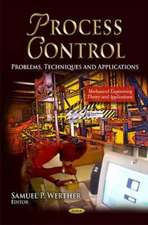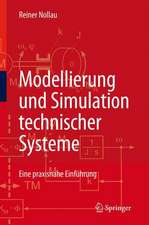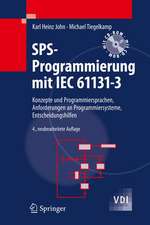Automation: The Future of Weed Control in Cropping Systems
Editat de Stephen L. Young, Francis J. Pierceen Limba Engleză Hardback – 9 dec 2013
| Toate formatele și edițiile | Preț | Express |
|---|---|---|
| Paperback (1) | 943.73 lei 6-8 săpt. | |
| SPRINGER NETHERLANDS – 17 sep 2016 | 943.73 lei 6-8 săpt. | |
| Hardback (1) | 949.73 lei 6-8 săpt. | |
| SPRINGER NETHERLANDS – 9 dec 2013 | 949.73 lei 6-8 săpt. |
Preț: 949.73 lei
Preț vechi: 1158.20 lei
-18% Nou
Puncte Express: 1425
Preț estimativ în valută:
181.75€ • 197.36$ • 152.67£
181.75€ • 197.36$ • 152.67£
Carte tipărită la comandă
Livrare economică 22 aprilie-06 mai
Preluare comenzi: 021 569.72.76
Specificații
ISBN-13: 9789400775114
ISBN-10: 9400775113
Pagini: 300
Ilustrații: XII, 265 p. 86 illus., 47 illus. in color.
Dimensiuni: 155 x 235 x 20 mm
Greutate: 0.57 kg
Ediția:2014
Editura: SPRINGER NETHERLANDS
Colecția Springer
Locul publicării:Dordrecht, Netherlands
ISBN-10: 9400775113
Pagini: 300
Ilustrații: XII, 265 p. 86 illus., 47 illus. in color.
Dimensiuni: 155 x 235 x 20 mm
Greutate: 0.57 kg
Ediția:2014
Editura: SPRINGER NETHERLANDS
Colecția Springer
Locul publicării:Dordrecht, Netherlands
Public țintă
Lower undergraduateCuprins
Forward; Simon Blackmore.- Preface; Stephen L. Young.- Acknowledgements.- Introduction: Scope of the Problem – Rising Costs and Demand for Environmental.- Safety for Weed Control; Stephen L. Young, Francis J. Pierce, and Pete Nowak.- Part I Agricultural Production Systems.- Current State of Organic and Conventional Cropping Systems; Alec F. McErlich and Rick A. Boydston.- Part II Principles and Merging of Engineering and Weed Science.- Engineering Advancements; John K. Schueller.- Plant Morphology and the Critical Period of Weed Control; J. Anita Dille.- The Biological Engineer: Sensing the Difference between Crops and Weeds; David C. Slaughter.- Part III Primary Weed Control Tools for Automation.- Precision Planting and Crop Thinning; Scott A. Shearer and Santosh K. Pitla.- Automated Mechanical Weeding; M. Taufik Ahmad, Lie Tang, and Brian L. Steward.- Targeted and Micro-Dose Chemical Applications; Stephen L. Young and D. Ken Giles.- Part IV Field Applications.- Field Applications of Automated Weed Control: Western Hemisphere; Steven A. Fennimore, Bradley D. Hanson, Lynn M. Sosnoskie, Jayesh B. Samtani, Avishek Datta, Stevan Z. Knezevic, and Mark C. Siemens.- Field Applications of Automated Weed Control: Northwest Europe; Jan Willem Hofstee and Ard T. Nieuwenhuizen.- Field Applications of Automated Weed Control: Asia; Hiroshi Okamoto, Yumiko Suzuki, and Noboru Noguchi.- Part V Economies for Automated Weed Control.- Economics of Technology for Precision Weed Control in Conventional and Organic Systems; Florian Diekmann and Marvin T. Batte.- Future Adoption of Automation in Weed Control; Josse De Baerdemaeker.- Automation for Weed Control in Least Developing Countries (LDCs); Renan Aguero, Noel M. Estwick, and Edgar Gutierrez.- Part VI Future Directions.- Future Directions for Automated Weed Management inPrecision Agriculture; Stephen L. Young, George E. Meyer, Wayne Woldt.- Appendix.- Glossary.- Index.
Textul de pe ultima copertă
This book shifts the paradigm that weeds can only be controlled using broadcast applications of chemical and mechanical techniques in distinct spatiotemporal scales, also referred to as integrated weed management. In fact, true integrated weed management is more than just diversification of techniques and for the first time could be achieved using advanced technologies. Automated weed control is not the proverbial ‘silver bullet’, but an entirely new approach in cropping systems where multiple weed control strategies are available for use at the same time.
In an automated system, sensor and computer technologies onboard a robot would first categorize each and every plant in a farmer’s field as either weed or crop, and then go on to identify the species of weed. Once those identifications were made, multiple weed fighting strategies located on a single platform could be applied to individual plants based on their biology. If the system identified a weed that’s resistant to Roundup™, for example, it could be spritzed with a different herbicide. Or an onboard cutting or flaming micro-tool could be used to kill the plant instead.
The production of a book that addresses weed control of the future will have profound impacts on current and future cropping systems across the globe. To date, no other resource exists on this important and rapidly advancing topic of automated weed control in cropping systems. In the near future, a new approach will be needed for managing weeds, especially with the challenges of weed resistance to herbicides, off-site movement of soil, fertilizers, and chemicals, an increasingly non-agrarian public, labor shortages, economies in recession, and the continued rural to suburban land use conversion. Automation is part of the solution.
In an automated system, sensor and computer technologies onboard a robot would first categorize each and every plant in a farmer’s field as either weed or crop, and then go on to identify the species of weed. Once those identifications were made, multiple weed fighting strategies located on a single platform could be applied to individual plants based on their biology. If the system identified a weed that’s resistant to Roundup™, for example, it could be spritzed with a different herbicide. Or an onboard cutting or flaming micro-tool could be used to kill the plant instead.
The production of a book that addresses weed control of the future will have profound impacts on current and future cropping systems across the globe. To date, no other resource exists on this important and rapidly advancing topic of automated weed control in cropping systems. In the near future, a new approach will be needed for managing weeds, especially with the challenges of weed resistance to herbicides, off-site movement of soil, fertilizers, and chemicals, an increasingly non-agrarian public, labor shortages, economies in recession, and the continued rural to suburban land use conversion. Automation is part of the solution.
Caracteristici
Chapters written by experts in the fields of engineering, weed science, and economics Comprehensive and cutting-edge information on automation and weed control from all across the world Fundamental principles on weed biology and engineering principles along with economics and market readiness associated with automated weed control














